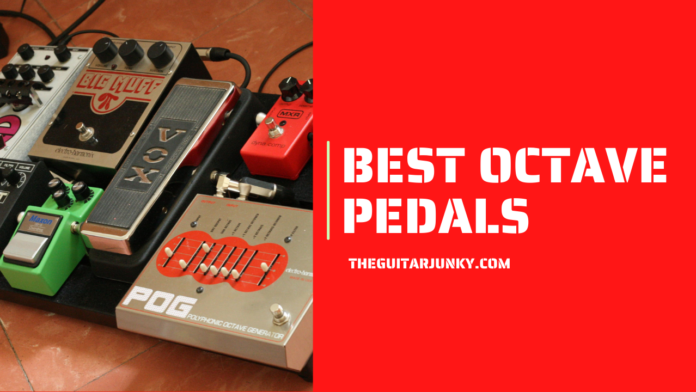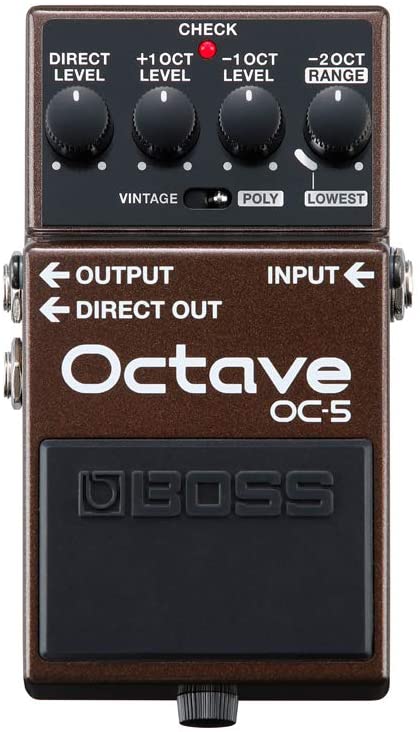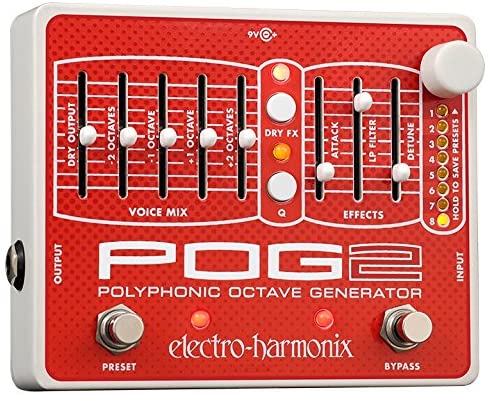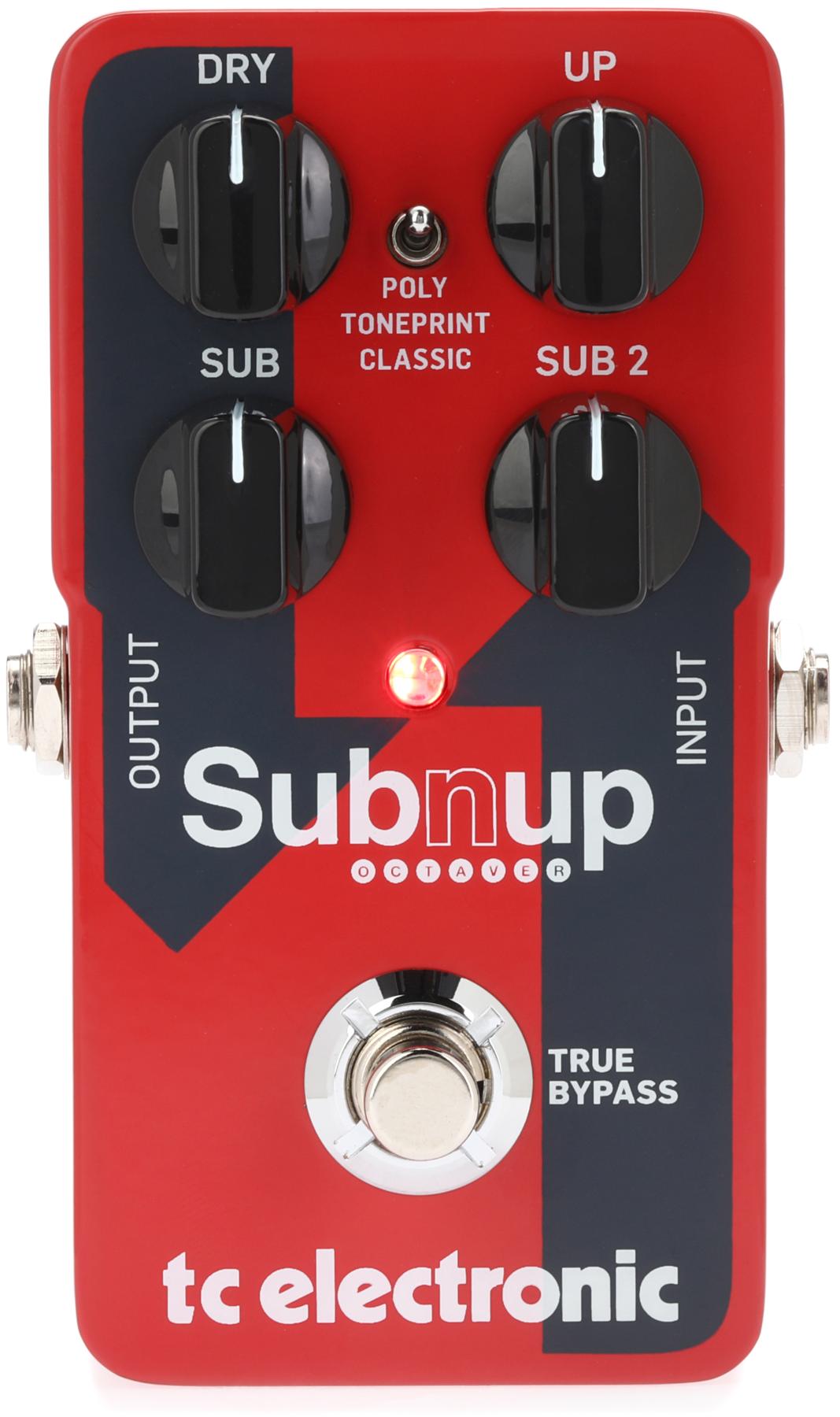A great way to expand the sounds on your guitar is using a pedal or two.
This is how Jimi Hendrix managed to play the fuzz and riffs on his guitar solo on his song Purple Haze — with Tycobrahe’s Octavia’s help.
Expanding the horizons of your guitar playing can be aided by the use of guitar pedals that help shape the sound you want to achieve like the Electro-Harmonix POG2.
Here is a guide to ten of the best octave pedals for guitar that are grabs in the market right now.
Contents
Here are the Best Octave Pedals
- Electro-Harmonix POG2
- Boss OC-5 Octave Pedal
- TC Electronic Sub ‘N’ Up
- Electro-Harmonix Nano POG
- MXR M288 Bass Octave Deluxe Pedal
- Danelectro 3699
- Source Audio Spectrum Intelligent
- Gamechanger Audio Third Man Records Plasma Coil
- Fulltone Octafuzz OF-2
- Behringer UO300 Ultra Octaver Pedal
Also Great | Editor's Choice | Budget Pick |
Electro-Harmonix POG2
POG2 is the sequel to the 2005 Electro Harmonix POG octave pedal that found fans worldwide — not to mention Jack White himself.
It was released in 2009 with all the fantastic features of the original POG in a more compact package.
The 2009 POG2 is revamped with an enhanced algorithm that lets you save and recall eight presets you just came up with; they added a second sub-octave, an attack control, among others.
The EHX POG2 has five mixable polyphonic octave harmonics making the possibilities for endless tones; you can go from monstrous heavy metal beats to angels playing the organ with a turn of some knobs.
The 2009 version has an upgrade with an attack control that allows you to fade in rich, smooth swells.
The POG2 is a staple for your pedalboard, offering all these features in a compact red box.
It’s perfect for use live for professional players (think Josh Homme of Queens of the Stone Age, Them Crooked Vultures, and, of course, Jack White of the White Stripes and The Raconteurs) and intermediate players who are going to be finding something new every time they play around with the POG2.
Pros
- One of the best octave pedals
- Trusted brand
- Better than the original POG
Cons
- Faders could be damaged easily
Boss OC-5 Octave Pedal
BOSS pedals are standard-bearers; for a long time, they have had no one to compete with but themself.
Here’s another thing to add to their repertoire of exquisite guitar pedals: The BOSS OC-5 Octave Pedal — the latest descendant of the OC-2 released in 1982.
It’s OC-3 on steroids.
The BOSS OC-5 is a do-it-all octave pedal with an instrument switch enhancing it for lead guitar and bass use.
The BOSS OC-5 Octave pedal’s brand spanking new tracking technology assures low latency and no dropped notes allowing for a smooth transition.
It has that vintage setting that mimics the sound of the original BOSS OC-2 mono octaves everyone and their brother fell in love with in the 80s.
The BOSS OC-5 improves the tone on fingerstyle acoustic guitar; it adds an octave below the note you play on the guitar, usually not found on acoustic guitars.
You can essentially be in a one-person band with this thing on your pedalboard.
The polyphonic mode on this guitar pedal is straight up the BOSS OC-3 but better; it enhances melodies, sounds, and textures, fleshing out power chords, barre chords, and open chords with bass-like notes.
All things considered, the BOSS OC-5 is an excellent addition to the Octave pedal line providing the classic capabilities with today’s new technology.
Pros
- Flexible octave shifting
- Exquisite tracking
- Great tones
Cons
- Subtle tones without dirt box
TC Electronic Sub ‘N’ Up
A favorite amongst the pack of pitch-shifting pedals is the new addition to the TonePrint series, the TC Electronic’s Sub ‘N’ Up Octaver.
It’s a compact, highly versatile octave machine that could make your guitar belt out single notes like a canary then turn into a Jimi Hendrix with a turn of some knobs: the up, the sub, the dry, and the sub 2 knobs.
The Sub ‘N’ Up has an intuitive three-way toggle switch that grants choice between a polyphonic setting, a TonePrint selector, and the classic old-school non-traditional polyphonic mode.
It’s perfect for the professional and the neophyte alike looking to venture into some inventive and experimental sounds.
The Sub ‘N’ Up uses the TC Electronix TonePrint, and with the TonePrint tech, you can tap into a library of artists’ created patches then beam it up on the Sub ‘N’ Up using your smartphone.
You can access virtually endless combinations, and you can make your own combination using the step editor; the Sub ‘N’ Up will make anyone feel like a better player.
With its to-die-for smooth polyphonic transitions and the practically endless flexibility in tones granted by TC Electronic’s TonePrint technology, the Sub ‘N’ Up is so versatile you are getting a lot more than the value for your money.
Pros
- Great tones
- TC Electronic’s TonePrint Technology
- Value for money
Cons
- The overwhelming variety of possible sounds
Electro-Harmonix Nano POG
The Electro-Harmonix Nano POG is the budget POG2 without compromising its name and fame.
The Nano POG provides a simple one octave up, an octave down sound (while its older brother, the POG2, offers twice as many) with three controls you can mix together: the sub-octave, the octave up, and the dry — to create new and totally inspiring tones.
It provides no filter or modification to the transported tones, but it just works, tending to yield superb results like magic, turning your guitar into a twelve-string one, into a bass, and even an organ.
The Electro-Harmonix Nano POG is designed with the needs of beginners and professional artists in mind affording you pro-level functions in an easy-to-navigate and use pedal.
The Nano POG’s tracking is impressive for such a tiny pedal there’s no glitch, no hiccups as many other pitch-tracking pedals tend to have.
The octave-up intersection does not sound as organic as its predecessor, the POG2 — there’s a bit of a grainy quality expected from a lower-cost alternative, but there’s so much more to this bitesize pedal than its one drawback.
The Nano POG is a small red box of awesomeness that ticks every box expected on an octaver: range, convenience, price, and performance.
Pros
- Space-saving design
- Durable die-cast casing
- Excellent tracking
Cons
- Octave-up tones sound inert
MXR M288 Bass Octave Deluxe Pedal
The MXR Bass Octave Deluxe is one of MXR’s new offerings, and believe me when we say you’re going to be transported back to the funky seventies when you hear it.
The MXR Bass Octave Deluxe is housed in a compact, solid housing much like the Phase 90 pedals, and that’s where the similarities stop.
The MXR Bass Octave features an analog tone with a true bypass allowing your guitar to keep its pure tone from the guitar to the amp — it also has a MID+ button that will boost mid frequencies for even more penetrating power.
The MXR Bass Octave Deluxe has three rotating knobs — DRY controls for a clean signal, the GROWL knob controls the octave below that gives punchy notes, and GIRTH deals with the level above with a soft, more subtle tone. These knobs can be used individually, or you can mix them for styles as you see fit.
The MXR M288 is a value for your money, and it is not the cheapest but also not the most expensive.
It is also right in the middle, and with the features and the excellent sound quality, there is more than value for your money.
Pros
- Splendid tracking
- Wide range of sounds
- Great value for money
Cons
- Side mounted knobs
Danelectro 3699
The Danelectro 3699 is the revamped version of the lust after FOXX Tone Machine sold in the 1970s.
The Danelectro 3699 features an undoubtedly more pronounced octave now with a dedicated footswitch, a warmer tone overall, and a mid-boost toggle cancel out the mid-cut of the initial pedal.
The 3699’s footswitches are near each other, which is a boon and a bane in the design; extra care should be taken to not bypass the pedal entirely though it is also an improvement over the toggle that performs the same function as the original.
The Danelectro 3699 retains those old-school tones with an upgrade with the overall warmer tones; when you try going in with a humbucker, the octave really cuts, making a Telecaster sound precisely like a Les Paul neck humbucker.
The 3699, encased with its artfully antiqued red housing and vintage-looking yellow arrow knobs, is probably one of the most flexible octave fuzzes you’ll ever play.
Pros
- Rich fuzz tones
- Octave with footswitchable
- Overall warm tone
Cons
- Footswitches are close together
Source Audio Spectrum Intelligent
Source Audio poured all their broad filter design expertise and proficiency into Spectrum Intelligent Filter, a compelling stereo filter pedal that gives off excellent envelope sounds to your guitar or bass rig.
The Spectrum packs easy access to tones influenced by some of the most iconic and elusive envelope filter effect pedals on the market.
The Spectrum sports the three-way toggle switch and four knobs branded by all Source Audio’s compact models.
It offers three modes influenced by the OG filter pedals of the past, such as the Lovetone Meatball and the Mu-Tron, with eight editable functions directly from the pedal and so much more you can access via MIDI and through the Neuro editing app straight from your phone.
The Spectrum allows you to store six resets on the pedal, and in the app, you get access to a wide collection of ready-made presets and tones by Source Audio.
The Spectrum features synth-like tones: the distorted octave and the envelope phaser sounds; the thrust toggle setting gives a lower octave to the filter sound that is a winner.
The Spectrum Intelligent Filter pedal is brilliant; the list of features is immense; there’s a library of presets, an app; no shortchange, certainly a value for one’s buck.
Pros
- Superb tracking with quick response
- Great sounds with tons of option
- Iconic envelope filter sound
Cons
- It can drift
Gamechanger Audio Third Man Records Plasma Coil
A distortion and octave pedal teamed upon by a heavy-hitter brand on the pedal world and a world-famous rockstar — this is the Plasma Coil, the brainchild of Game Changer Audio, Third Man Records, and The White Stripes and The Raconteurs’ Jack White.
Like the original Plasma Pedal — The Plasma Coil is a high-voltage distortion pedal that converts audio signals into a 3500-volt electrical charge, detonating through a xenon-filled vacuum tube resulting in a speaker-melting out-of-this-world distortion, only now better than ever with an upgrade in blend control and the addition of a second footswitch for special effects.
The plasma Coil is taking High Voltage distortion to new levels by adding Octaver-style circuits and the addition of an effective footswitch that can be switched between latching or momentary.
It features two sub-octave modes, one upper-octave mode, and two mixed-octave modes to blast dense fuzz and distortion sound that is the signature and staple of Jack White’s tone armory.
The Plasma Coil is not just for guitar — it also sounds great on bass, synth, and drums.
The Plasma Coil is great for adventurous players as it delivers an amazing variety of octave down and octave up textures with excellent melodic glory.
Pros
- Innovative
- Yellow lightning-like bolts seen on pedal
- Amazing distortion and fuzz
Cons
- Don’t include power supplies
Fulltone Octafuzz OF-2
The Fulltone OF-2 Octafuzz, the only exact copy of the well-known Tycobrahe Octavia famously utilized by Jimi Hendrix and Stevie Ray Vaugh.
Fulltone is notorious (in the best of ways) at replicating vintage circuits for today’s customers for a fraction of the cost, seeing as the originals run for hundreds even thousands of dollars, and no pedal has come closer to the Octavia than the Octafuzz.
The Fulltone Octafuzz has the exact circuitry as the Octavia as it is developed with the same transistors from the same brand — this is a crucial part of the cloning of that sound known in history.
Your guitar volume knobs will play a huge role in utilizing the sound effects of the Fulltone Octafuzz — guitarists would not have the problem of leaning down and fuzzing over the controls of the Octafuzz since the onboard switches only include the essentials; it is a learning curve, but it will be a huge help for other artists mid-performance.
The Fulltone Octafuzz shines in terms of sound as you could switch between both octave and fuzz effects that you could mix together with the octave-up sounds or switch to octave or fuzz individually.
Octafuzz does everything it claims with perfection, and you won’t be disappointed.
Pros
- Superb and clear sound
- Amazing range in octave and fuzz
- Tycho Brahe’s son
Cons
- Not very versatile
Behringer UO300 Ultra Octaver Pedal
Here is a funky octaver tone machine that offers amazing performance and extreme affordability — the Behringer UO300 Ultra Octaver Pedal.
This guitar features a 3-mode range control with Hi, Mid, and Lo settings that lets you define the range you want for your guitar or bass perfectly, while the Ultra Octaver’s volume controls command both of its octave voices that let you create and mix sounds.
The Ultra Octaver also generates two octaves below the guitar and bass’ original tone allowing you to play synth-like tones with both your guitar and bass.
The Ultra Octaver is also crazy versatile as it could be used not just for your guitar or your bass — it could also be plugged in on your keyboard.
With its amazing affordability, versatility, its features — the Ultra Octaver is hard to beat.
Pros
- Not just for guitars and basses
- Easy to use
- Range of low tones
Cons
- Could be glitchy on the trebles
Buying Guide
Here is a 101 on the basics of guitar pedals you can note when purchasing your first guitar pedal.
Common Effects Pedals
Distortion
One of the most popular guitar pedals.
It is also called the “fuzz” or the “overdrive” pedals, depending on where they are on the spectrum of distortion.
Its main sound is that heavy, aggressive sound that is the hallmark of alternative hard rock and heavy metal music.
Reverb
Reverb is characterized by the echo effect this guitar pedal conjures in a large concert ground.
It is a great way to thicken up an undistorted and clean guitar tone.
Reverb pedals are usually used in conjunctions with other different pedals to complement their tones.
Delay
Delay pedals copy each note a guitarist plays and repeat it with a gradual fading away effect, like a well-defined echo.
Chorus
Chorus pedals replicate the sound you play in a guitar and make it sound like multiple guitars are playing the same notes — some with a varying tune and fading out with wavering vibratos.
Wah-Wah
A song that embodies this onomatopoeia of an effect is the first few bars on the opening of Jimi Hendrix’s song “Voodoo Child.”.
One of the best guitar pedals for genres like funk, rock, and metal.
Looper
Looper pedals record a brief bar of your playing and play it back for an endless repeat.
FAQs
Which guitar pedal should I buy first?
Pedal choice is subjective; it depends on the genre of music you play and even the types of guitar and amplifiers you use.
If you’re partial to jazz and are playing a Stratocaster, an effect that gives the illusion of space might be the right pedal for you, and the pedal that can emulate that effect is a Reverb pedal.
Researching is integral before buying.
How much do guitar pedals cost?
Guitar pedals can range anywhere between $50 to a thousand for vintage models.
Multi-Effects Pedals vs. Single Effects Pedals?
It’s advisable to stick to single effect pedals if you are a beginner since a major disadvantage to multi-effects pedals is they have a bit of a learning curve, and multi-effects tend to be always digital, whereas it’s not the case for single-effect ones.
Editor’s Pick
There you have the best of the best octave pedals on the market to choose from and use for yourself.
As you’d notice, they have different features and specifications, so in the end, the choice is still dependent on your needs and preferences.
But for me, my favorite is the EHX POG2 for its mixable polyphonic octave harmonics and upgraded attack control for fading in rich and smooth swells. You might want to check it out yourself.













